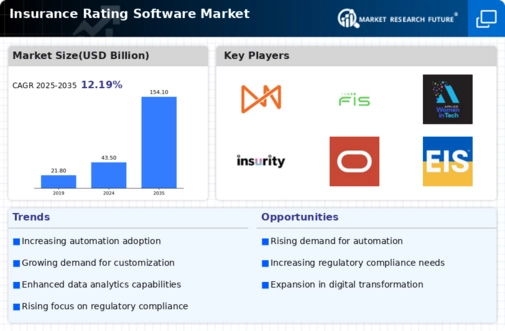Increased Competition
Increased competition within the Global Insurance Rating Software Market Industry is prompting insurers to adopt more sophisticated rating solutions. As new entrants disrupt traditional markets, established players are compelled to innovate and enhance their pricing strategies to retain market share. This competitive landscape encourages the development of advanced software that can quickly adapt to market changes and customer demands. For instance, insurers are increasingly utilizing predictive analytics to forecast trends and adjust their offerings accordingly. This shift not only improves profitability but also fosters a more dynamic market environment, where agility and responsiveness are paramount.
Regulatory Compliance
Regulatory compliance remains a crucial driver within the Global Insurance Rating Software Market Industry. Insurers are increasingly required to adhere to stringent regulations that govern pricing, underwriting, and claims processing. This has led to a heightened demand for sophisticated rating software that can ensure compliance while optimizing operational processes. For example, software solutions that integrate regulatory updates in real time can help insurers avoid penalties and maintain their competitive edge. As regulatory frameworks evolve, the need for robust insurance rating solutions is likely to increase, further propelling market growth and innovation.
Market Growth Projections
The Global Insurance Rating Software Market Industry is projected to experience substantial growth, with estimates indicating an increase from 43.5 USD Billion in 2024 to 154.1 USD Billion by 2035. This trajectory suggests a robust compound annual growth rate of 12.19% from 2025 to 2035. Such growth is indicative of the increasing reliance on technology-driven solutions within the insurance sector, as companies seek to enhance efficiency and customer satisfaction. The anticipated expansion reflects broader trends in digital transformation and the ongoing evolution of the insurance landscape, positioning the market for continued innovation and development.
Technological Advancements
The Global Insurance Rating Software Market Industry is experiencing rapid technological advancements, particularly in artificial intelligence and machine learning. These innovations enable insurers to analyze vast amounts of data more efficiently, leading to more accurate risk assessments and pricing strategies. For instance, AI-driven analytics can process customer data in real time, allowing for personalized insurance products. As a result, the market is projected to grow from 43.5 USD Billion in 2024 to 154.1 USD Billion by 2035, reflecting a compound annual growth rate of 12.19% from 2025 to 2035. This growth underscores the importance of technology in enhancing operational efficiency and customer satisfaction.
Growing Demand for Customization
The Global Insurance Rating Software Market Industry is witnessing a growing demand for customized insurance products tailored to individual customer needs. As consumers become more discerning, insurers are compelled to leverage rating software that allows for flexible pricing models and personalized offerings. This trend is evident in sectors such as health and auto insurance, where tailored solutions can significantly enhance customer engagement and retention. Consequently, the ability to provide customized insurance solutions is becoming a key differentiator in the market, driving the adoption of advanced rating software that can accommodate diverse customer preferences.
Market Expansion in Emerging Economies
The Global Insurance Rating Software Market Industry is experiencing significant expansion in emerging economies, driven by increasing insurance penetration and economic growth. As countries in Asia and Africa develop their insurance markets, there is a rising demand for efficient rating software that can support diverse insurance products. For example, as more individuals gain access to insurance, the need for scalable and adaptable rating solutions becomes critical. This trend is expected to contribute to the overall market growth, as insurers seek to capitalize on new opportunities in these regions, further enhancing the global landscape of insurance rating software.





















Leave a Comment